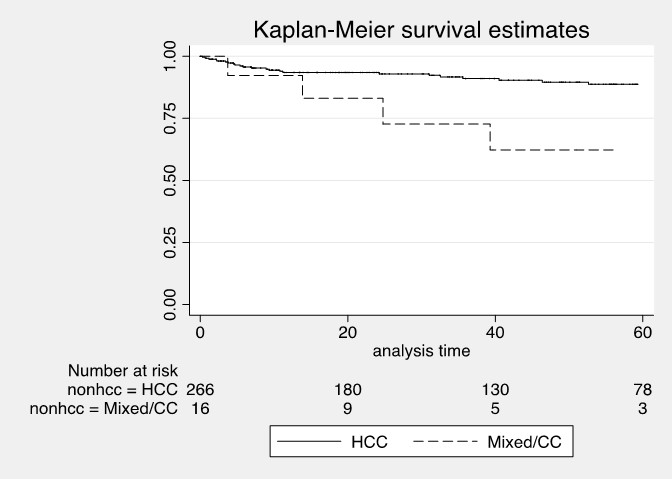Outcomes of Liver Transplantation for Combined Hepatocellular Cholangiocarcinoma: A Single-center Experience
1Internal Medicine, USC Keck School of Medicine, Los Angeles, CA, 2Radiology, USC Keck School of Medicine, Los Angeles, CA, 3Internal Medicine - Gastrointestinal and Liver Disease, USC Keck School of Medicine, Los Angeles, CA
Meeting: 2021 American Transplant Congress
Abstract number: 90
Keywords: Liver transplantation, Post-transplant malignancy, Survival, Tumor recurrence
Topic: Clinical Science » Liver » Liver: Hepatocellular Carcinoma and Other Malignancies
Session Information
Session Name: Liver Transplant Oncology
Session Type: Rapid Fire Oral Abstract
Date: Saturday, June 5, 2021
Session Time: 6:00pm-7:00pm
 Presentation Time: 6:35pm-6:40pm
Presentation Time: 6:35pm-6:40pm
Location: Virtual
*Purpose: Combined hepatocellular cholangiocarcinoma (cHCC-CCA) is a hepatic tumor that exhibits histological features of both hepatocellular carcinoma (HCC) and cholangiocarcinoma (CCA). cHCC-CCA is often diagnosed incidentally on explant. Clinical traits associated with cHCC-CCA and predictors of transplant outcomes should be identified to best allocate organs.
*Methods: 308 patients who underwent OLT for the indication of HCC as well as those with cHCC-CCA found on explant at Keck Hospital from 2002 to 2020 were reviewed. A cohort of patients with cHCC-CCA on explant was identified, and features/outcomes were compared to patients with HCC alone on explant.
*Results: 15 patients were identified to have cHCC-CCA or both HCC and CCA; 1 patient had isolated CCAs on explant. HCV was the major etiology of cirrhosis in both cohorts. Three cHCC-CCA phenotypes were identified: cHCC-CCA with other HCC or CCA nodules (n=6), cHCC-CCA alone (n=5), and concurrent discrete HCC and CCA nodules (n=4). Microvascular invasion on explant was present in 31% of the cHCC-CCA cohort compared to 7% in pure HCC (p=<0.001). 3-year survival was 62% in the cHCC-CCA cohort compared to 88% for HCC (p=0.02).
*Conclusions: Demographic and clinical features between HCC and cHCC-CCA are nearly identical, necessitating further modalities such as biomarkers to be developed to identify cHCC-CCA to aid transplant evaluation. Three unique phenotypes of cHCC-CCA were identified, and further identification/long-term follow up of cases should be pursued to characterize survival respectively to revise exclusion/inclusion criteria for cHCC-CCA.
| HCC (N=270) | cHCC-CCA or CCA (N=16) | p-value | |
| Age | 60 (54-64) | 59 (51-66) | 0.97 |
| Male Sex | 76% | 75% | 0.96 |
| Race | 0.89 | ||
| -Hispanic | 49% | 63% | |
| -White | 28% | 25% | |
| -Asian | 20% | 13% | |
| MELD-Na at transplant | 13 (9-18) | 12 (9-16) | 0.81 |
| HCC (N=270) | cHCC-CCA or CCA (N=16) | p-value | |
| Total tumor size at OLT imaging, cm | 2.9 (1.5-4.2) | 3.2 (2.0-4.7) | 0.6 |
| AFP at OLT | 5.7 (3.3-13.2) | 6.1 (3.3-23.6) | 0.82 |
| # of Tumors | 1 (1-3) | 2 (1-3) | 0.09 |
| Well differentiated | 17% | 6% | |
| Moderately differentiated | 61% | 63% | |
| Poorly differentiated | 5% | 19% | |
| Microvascular Invasion | 6.5% | 31.3% | <0.001 |
To cite this abstract in AMA style:
Liu Y, Hanlon C, Zhou S, Toy D, King K, Zhou K, Kahn J, Yuan L. Outcomes of Liver Transplantation for Combined Hepatocellular Cholangiocarcinoma: A Single-center Experience [abstract]. Am J Transplant. 2021; 21 (suppl 3). https://atcmeetingabstracts.com/abstract/outcomes-of-liver-transplantation-for-combined-hepatocellular-cholangiocarcinoma-a-single-center-experience/. Accessed December 23, 2025.« Back to 2021 American Transplant Congress

